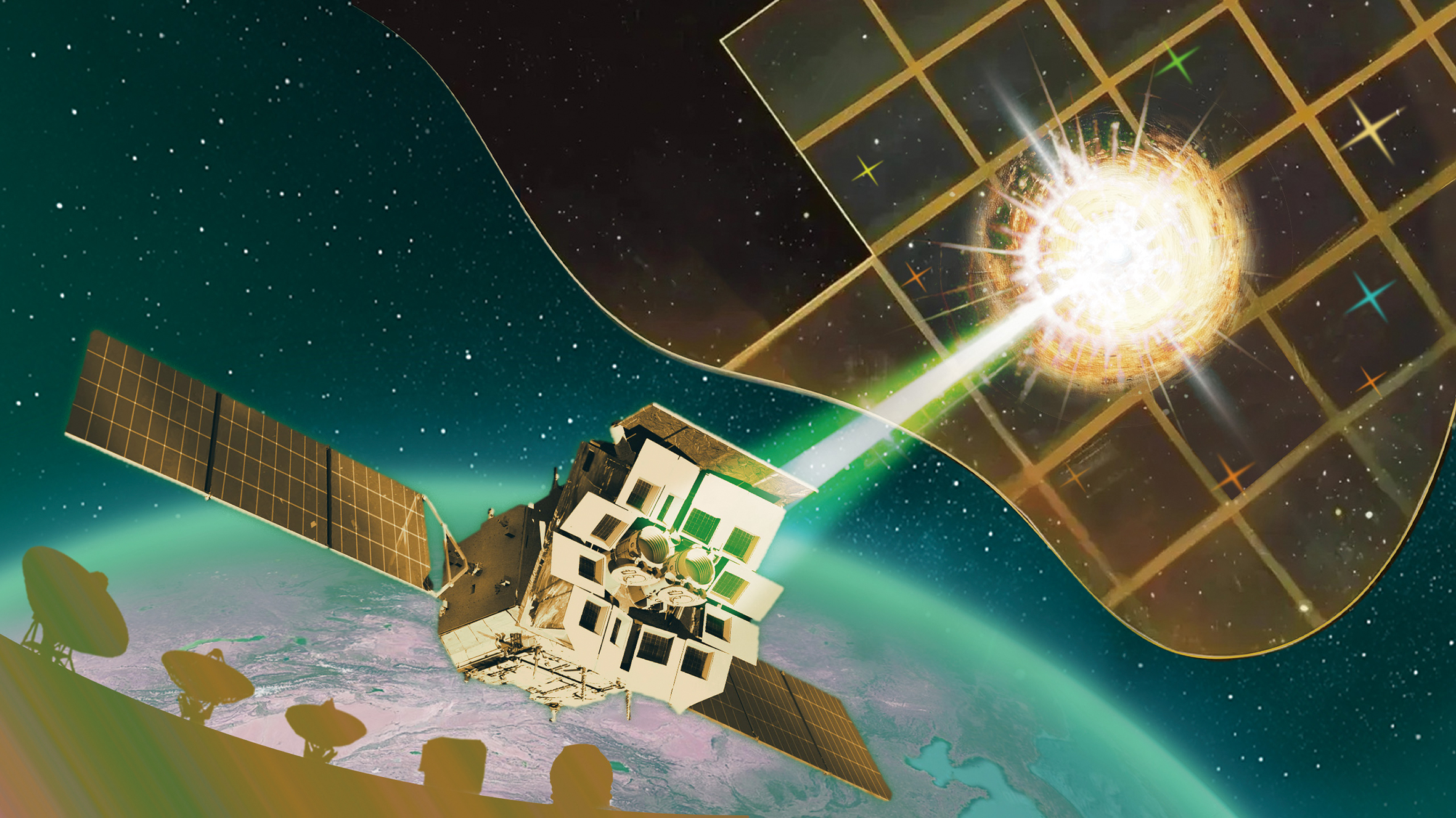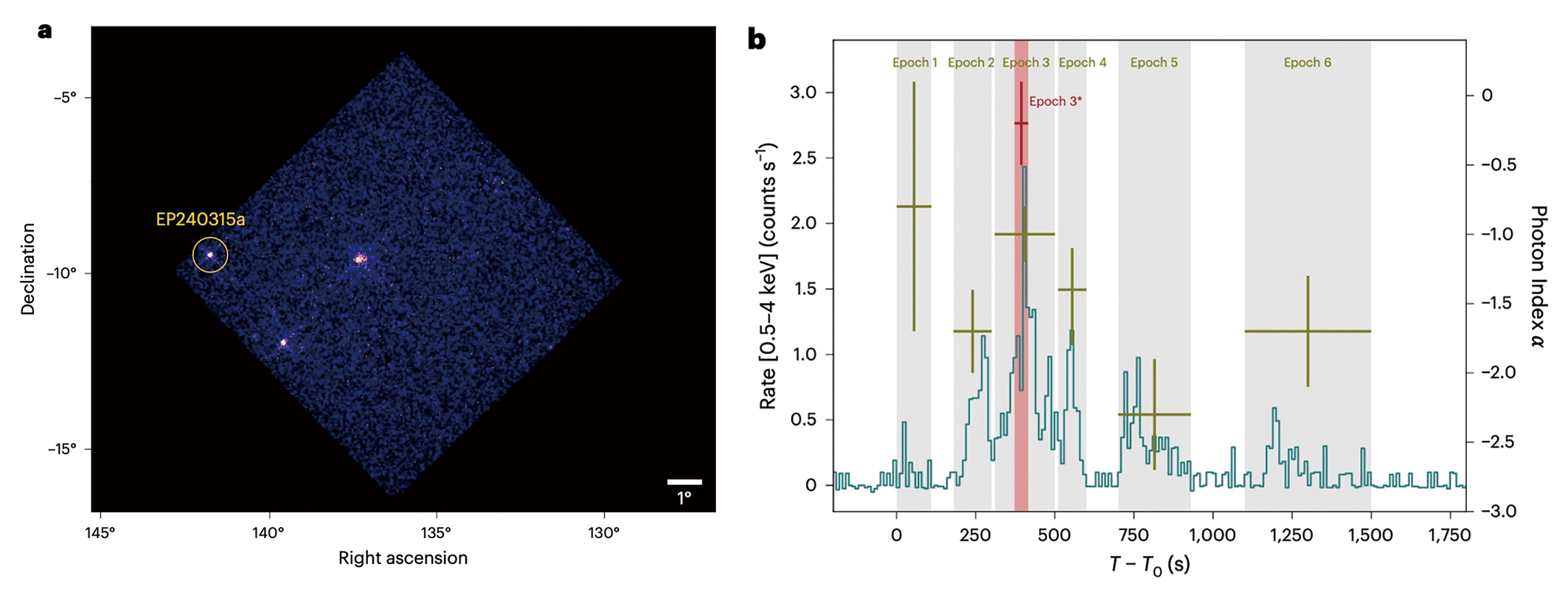Messenger from the Early Universe
By SONG Jianlan

Einstein Probe satellite offers unique opportunities to peer into the early X-ray cosmos. (Image credit: EP Team)
A team of researchers from the Beijing Normal University, the Institute of High Energy Physics (IHEP) under the Chinese Academy of Sciences (CAS), and the National Astronomical Observatories, CAS (NAOC), reported in Nature Astronomy on January 23, 2025 their discovery of an X-ray flash about 12.5 billion lightyears away. The signals burst out only 1.2 billion years after the Big Bang, when our 13.8-billion-year-old universe was still in its infancy, and a science satellite swiftly recorded them.
This marked the first successful detection of a soft X-ray burst from such an early phase of the universe. Observation of such high-redshift X-ray sources is challenging: Signals from sources at this distance are very dim and faint, and absence of X-ray focusing imagery for soft X-ray photons makes it difficult to obtain high-quality data. Thanks to Einstein Probe (EP), a satellite launched in January 2024, scientists got this dear opportunity to peer into the early cosmos.
Dedicated to time-domain high-energy astrophysics, EP is a mission initiated and sponsored by CAS in cooperation with the European Space Agency (ESA), the Max Planck Institute for Extraterrestrial Physics in Germany and the Centre National d’Études Spatiales (CNES) in France. It carries two main payloads: The Wide-field X-ray Telescope (WXT) in charge of all-sky monitoring, and the Follow-up X-ray Telescope (FXT) for follow-up observations focused on certain objects of interest. Thanks to the lobster-eye micropore optics, a novel X-ray focusing technology, the EP-WXT boasts an instantaneous field of view of 3,600 square degrees and a sensitivity more than one order of magnitude better than previous all-sky monitors.
Message from Early Cosmos
The EP-WXT detected this X-ray source named EP240315a on March 15, 2024. Lasting for about 17 minutes, it temporally and spatially coincided with GRB240315C, a gamma-ray burst (GRB) detected afterwards by multiple observatories, including the Burst Alert Telescope onboard the Neil Gehrels Swift Observatory (hereafter referred to as Swift-BAT) operated by NASA and the Konus-Wind, a GRB spectrometer of Russia.
Visible light from the same source was also picked up by optical telescopes both in the Northern and Southern Hemispheres. Observations by these telescopes, including those by the Gemini-North telescope in Hawaii in USA, and the Very Large Telescope in Chile, determined the redshift for this transient as about 4.859, confirming that the signals have come from around 12.5 billion years ago.
At this high cosmological redshift, the source brought clues about star and galaxy formation and the ambient environment in the early development of our cosmos. Actually, the profile recorded by EP challenges the present practice examining GRB signals.
Notably, the source EP240315a was detected during a long calibration observation when the instrument was still in its commissioning phase. Despite the fact that it was still under test and calibration, EP-WXT captured the signals from the early activation of the burst, all through the extended late activity in a continuous observation, covering a much broader temporal range than conventional GRB detectors and giving much more details.
Before the launch of EP, the detection rate of X-ray sources at high redshifts was notably low. Only merely 3% or less of the entire sample detected by Swift-BAT have redshifts higher than 4.5. Now with EP working in-orbit, scientists can anticipate a wave of new discoveries of such sources.
“It was really good to see the algorithm working fine for this event,” says Prof. LIU Yuan from the EP Science Center at NAOC. A co-first author of the paper, LIU is in charge of developing the onboard trigger algorithm for WXT.
An Interesting Profile
The detection of EP240315a also inspired the cooperation between EP team and a group led by Dr. Roberto Ricci from the Universitá di Tor Vergata of Italy. The latter conducted a three-month-long monitoring from two different radio wavelengths on this source, facilitated by the Australian Telescope Compact Array. The joint research verified that the energy outflow of EP240315a conformed to the characters of a GRB, and can be explained by a model of relativistic jet seen close to its axis. The joint team reported their discoveries in The Astrophysical Journal Letters on February 1.
“The results indicated that lots of fast X-ray transients might be related to gamma-ray bursts. And sensitive monitors like EP and the proposed HiZ-GUNDAM and Theseus missions, can successfully pinpoint their relativistic outflows up to high redshifts,” say the authors in the paper.
Still, the team found some especially mysterious characters in EP240315a. For example, prompt emission in gamma-ray band apparently started more than 6 minutes later than the onset of the soft X-ray burst. In contrast, generally such a delay measures merely dozens of seconds.
“Such a long delay has never been previously observed,” says Dr. SUN Hui from the EP Science Center at NAOC. A co-first author of the Nature Astronomy paper, SUN also participated in Ricci’s research. “This renewed our knowledge about GRBs and requires a reconsideration of GRB models,” emphasized Prof. GAO He, co-corresponding author of the Nature Astronomy paper and a professor from Beijing Normal University.
“This joint research across continents has demonstrated the possible key role EP can play in global synchronized observation and collaborations on high-energy time-domain astronomy,” remarked Prof. WU Xuefeng, deputy director of the Purple Mountain Observatory, CAS and chair of the Science Topical Panel on fast X-ray transients of the EP science team. WU is also a co-corresponding author of the Nature Astronomy paper.
Calling for A New Paradigm
Obviously, EP-WXT recorded much longer a duration of the burst from the soft X-ray band (0.5–4 keV) than did Swift-BAT and Konus-Wind from the gamma-ray band. Data obtained by EP-WXT clearly show that the central engine of EP230315a began its intense activity long before Swift-BAT and Konus-Wind were triggered on to record gamma-rays. This casts doubts on the routine practice using the duration determined by gamma-ray observations to examine the underlying central engine activity — the significant loss of information could visibly skew the results.
“Hence, our observations pose a challenge to previous analyses of the jet propagation and acceleration timescale based on the gamma-ray information only,” assert the authors in their Nature Astronomy article. Also, they remind of the discrepancy in the onset time defined by these two bands, warning of its possible substantial influence in analyzing the temporal behavior of the early emissions and derived physical explanations.
This suggests that we may need to re-examine the existing GRB models, said Prof. YUAN Weimin, Principal Scientist of EP and a researcher at NAOC.
“Therefore, we suggest that EP has ushered in an era of in-depth study of GRB central engine activity with the complementary observations of the gamma-ray detectors and depicting the temporal features of early emissions more properly,” state the authors in the paper.
“The era of soft X-ray detection of high-redshift GRBs has officially begun with EP,” the authors announce.

Soft-X-ray image and light curve of the prompt emission from source EP240315a as recorded by EP-WXT. Remarkably, EP-WXT records a much longer duration of the event, giving much detailed nuances of the multi-peaked structure and dynamics of light count evolution.
a, The image of EP240315a in one of the 48 CMOS chips of EP-WXT. The field of view of each CMOS is 9.3 × 9.3°2. In view are two other bright X-ray sources that were simultaneously detected.
b, The light curve of the net count rate and spectral evolution of EP240315a in the 0.5–4 keV band. The grey shaded areas indicate the six epochs used for spectral analysis, and the red shaded area indicates the time window in which gamma-ray emissions were detected by Swift-BAT and Konus-Wind. The vertical error bars of the photon indices represent the 1σ confidence level. The horizontal error bars represent the time interval of each epoch.
(Image credit: EP Team)
A Time Travel back to the Infancy of Our Universe
Comparing the data recorded by EP-WXT with the prompt emissions of high-redshift GRBs recorded by Swift-BAT, authors found that the former demonstrated a relatively faint peak flux in the soft X-ray band, and a much longer timescale. This indicates that EP-WXT has advantages in detecting faint transients due to its large field of view and excellent sensitivity. On the other hand, EP-WXT gives a longer exposure, therefore it can also detect the late X-ray emissions. This part of emission dynamics might be related to the central engine’s activity; therefore, the full-duration data could offer more comprehensive clues about the central engine.
Furthermore, EP-WXT provides a good localization of the source. Plus, it is capable of giving early warning and alerts to other ground- or space-based telescopes, hence can remarkably improve the efficiency of multiband follow-up observations via global synchronized observations. This not only can facilitate the identification of the early central engine activities and the multiband characteristics of the afterglow, but also considerably enhance the probability of redshift measurements, the authors introduce.
Excitingly, simulation indicates that EP can pick up objects from even earlier a time. Calculation shows that it can detect and observe dim, faint objects at redshifts as high as 7.5 (at a signal-noise rate above 7) or even higher (at lower signal-noise rate). This suggests that more GRBs with higher luminosity and redshifts will be discovered by EP in the future. The redshift of 7.5 corresponds to a time as early as about 700 million years after the Big Bang. At that time, the Epoch of Reionization was in full swing, the first stars, galaxies and quasars took their shape fast and kept ionizing the neutral hydrogen gas produced in the cooling plasma left by the Big Bang.
“The detection of EP240315a demonstrates EP’s great potential for discovering transients from the early Universe,” Prof. WU Xuefeng emphasizes the mission’s significance: “The mission will play an important role in international observations and collaborations.”
“This is just the beginning, and it really demonstrates the potential of EP to detect cosmic explosions from the early Universe,” adds YUAN Weimin, PI of EP.
Erik Kuulkers, the EP Project Scientist at ESA, comments: “As soon as we opened the eyes of EP to the sky, it found interesting new phenomena. That’s pretty good and should mean that there are a lot of more interesting discoveries to come.”
Reference
Liu, Y., Sun, H., Xu, D. et al. (2025) Soft X-ray prompt emission from the high-redshift gamma-ray burst EP240315a. Nature Astronomy. https://doi.org/10.1038/s41550-024-02449-8
Ricci, R., Troja, E., Yang, Y.H. et al. (2025) Long-term Radio Monitoring of the Fast X-Ray Transient EP 240315a: Evidence for a Relativistic Jet. The Astrophysical Journal Letters, 979: L28. https://doi.org/10.3847/2041-8213/ad8b3f

